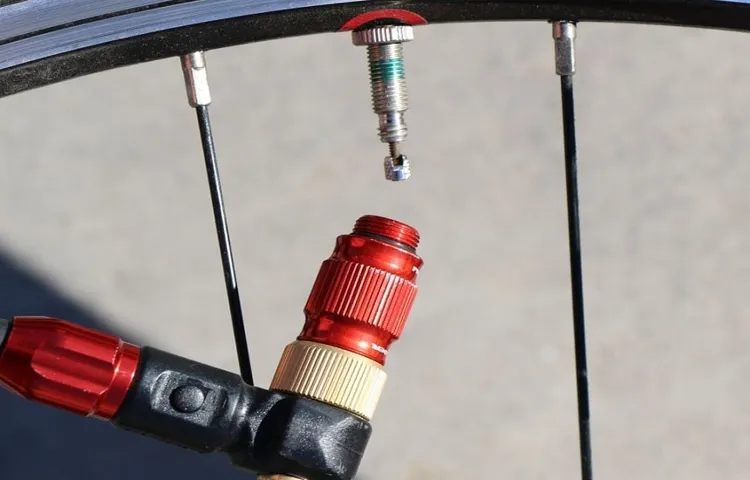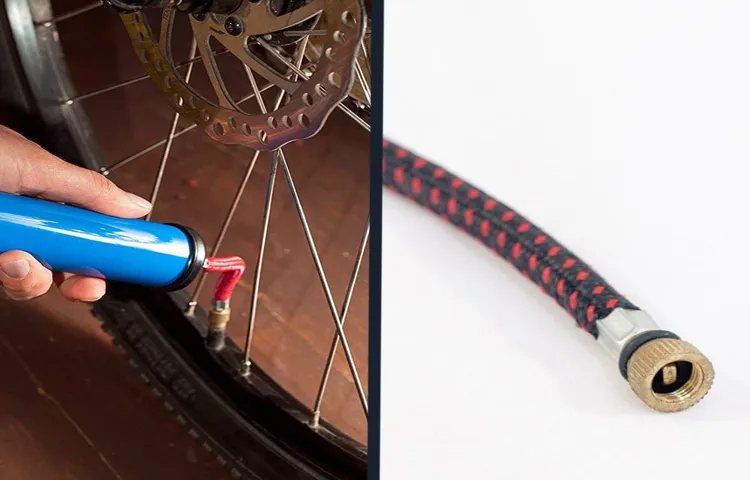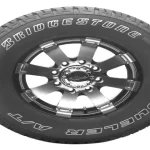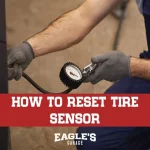Have you ever found yourself with a flat tire while out on a bike ride? It’s a frustrating feeling, but luckily, there are easy solutions to get you back on the road. One of these solutions is inflating your tire at a gas station. Yes, you heard that right! Gas stations can be a great resource for cyclists in need of a quick fix.
Not only is it convenient, but it’s also more affordable than purchasing a portable bike tire inflator. In this blog, we’ll discuss the step-by-step process of inflating your bike tire at a gas station, so you can confidently tackle any future flat tires on your rides with ease. So, let’s dive in!
Table of Contents
Check the Tire Pressure
If you’re looking to put air in your bike tire at a gas station, it’s important to first check your tire pressure. The recommended tire pressure should be listed on the side of your tire, and it’s important to make sure you don’t overinflate or underinflate your tires. Once you know your tire pressure, head over to the air pump at the gas station.
Many of these pumps have attachments specifically for inflating bike tires, so make sure to use the right one. First, remove the valve cap from your tire and press the attachment onto the valve stem. Press down to lock it into place, and then start the pump.
When the tire is inflated to the recommended pressure, you can release the attachment and replace the valve cap. And just like that, you’ll have a fully inflated bike tire ready to hit the road!
Use a Tire Pressure Gauge
When it comes to maintaining your vehicle, checking the tire pressure is an essential task. It not only ensures your safety on the road but also helps in maximizing fuel efficiency and prolonging the life of your tires. Using a tire pressure gauge is the best way to accurately check the pressure in your tires.
By simply pressing the gauge onto the valve stem and reading the pressure measurement, you can quickly determine if your tire is overinflated or underinflated. It’s important to note that tire pressure should be checked when the tires are cold, as heat generated from driving can increase tire pressure and give a false reading. Taking the time to check your tire pressure with a gauge can save you from potential accidents, improve your driving experience, and save you money in the long run by preventing premature wear and tear on your tires.
So, next time you fill up your gas tank, take a minute to check your tire pressure with a gauge and ensure that your vehicle is performing at its best.

Refer to the Manufacturer’s Recommended Pressure
Are you checking your tire pressure regularly? It’s important to keep your tires inflated to the manufacturer’s recommended pressure for optimal performance, safety, and fuel efficiency. If you’re not sure what that pressure is, you can find it in your vehicle’s owner manual, inside the driver’s door jamb, or on the sidewall of your tire. While it might be tempting to just guess or pump them up to the maximum pressure listed on the tire, that’s not the best option.
Overinflated tires can be just as dangerous as underinflated ones, and they can cause uneven wear and a harsh ride. On the other hand, if your tires are underinflated, they can reduce your gas mileage, wear out faster, and even overheat and blow out. So, make it a habit to check your tire pressure at least once a month, or before a long trip, and adjust it accordingly.
It only takes a few minutes and can save you a lot of hassle down the road. Remember, proper tire inflation is key to a smooth and safe ride.
Find the Gas Station’s Air Pump
If you need to put air in your bike tires and you don’t have a pump at home, a gas station can be a great solution! Most gas stations have air pumps available for customers to use, but finding them can sometimes be a challenge. Here’s what you need to do: look for a sign indicating the location of the air pump. Usually, it’s near the gas station or the car wash area.
Once you’ve found it, check the pressure on your bike’s tires to determine how much air you need to add. Then, follow the instructions on the air pump machine. Make sure that the pump is set to the appropriate pressure level and connect the hose to your bike tire valve.
Start pumping the air until you reach the desired pressure. Remember to double-check the pressure using a tire gauge before you head back on the road. Putting air in your bike tires is an important step in maintaining them and ensuring a safe ride.
With these simple steps, you’ll be back pedaling in no time!
Look for a Compressor or Air Hose
Looking for a compressor or air hose at a gas station can be a great way to top up your car tires without having to spend extra money at a mechanic. But finding the gas station’s air pump can sometimes be a challenge. First off, make sure to have a look around the gas station for the compressor or air hose itself.
They may be tucked away in a corner or out of sight, so be sure to look high and low. If you’re still struggling to locate the pump, try asking the gas station attendant for help. They may even be able to guide you to the right location or inform you if there’s an issue with the pump’s availability.
Remember, keeping your tires at the right pressure can help improve your fuel efficiency and keep you safe on the roads. So, it’s always good practice to keep an eye on your tire pressure and top up as needed.
Check if the Station Charges for Air
When you’re on the road and your tire pressure is running low, the last thing you want is to have to pay for air at a gas station. Before you pull up to a pump and start fumbling for change, take a moment to check if the station charges for air. Many stations offer free air pumps, but some charge up to $
50 per use. To save yourself some money, look for the air pump somewhere on the premises of the gas station. They can vary in location from near the entrance or exit, or even tucked away in a corner somewhere.
Don’t be afraid to ask an attendant for help if you can’t locate it. It’s important to keep your tires properly inflated for optimal performance and to avoid potential hazards on the road. So next time you need air, make sure to find a gas station that offers it for free.
Attach the Air Pump to the Valve Stem
If you want to know how to put air in a bike tire at a gas station, the first step is to attach the air pump to the valve stem. This may sound easy enough, but it’s important to make sure you’re using the right nozzle for your bike tires. Most gas station air pumps have both Presta and Schrader nozzles, which are the two types of valve stems typically found on bike tires.
Once you’ve identified which type of nozzle you need, it’s simply a matter of aligning it with the valve stem on your tire and pressing down. The air pump should start inflating the tire, and you can monitor the pressure using a gauge on the pump or a separate pressure gauge. Be sure to inflate your tires to the recommended pressure level, which is typically printed on the sidewall of the tire or listed in the owner’s manual.
Overinflated or underinflated tires can affect your bike’s handling and increase the risk of a puncture or blowout. So, take the time to properly inflate your tires, and enjoy a smoother, safer ride!
Remove the Valve Cap
When it comes to inflating your tires, knowing the proper technique is essential. Before attaching the air pump to the valve stem, it’s crucial to remove the valve cap. This cap protects the valve from dirt and debris, but it can also hinder the flow of air when inflating your tire.
After removing the cap, locate the valve stem and attach the air pump securely. Make sure to line up the nozzle with the valve stem and press the lever or handle to begin inflating. Checking the recommended pressure for your tires is also important before inflating to avoid under or overinflation, which can affect your driving performance and safety.
With these simple steps, you can efficiently inflate your tires, ensuring a smoother and safer ride on the road. So what are you waiting for? Start getting your tires in tip-top shape today!
Press the Pump Nozzle onto the Valve Stem
When it comes to inflating your tires, it’s essential to know how to attach the air pump to the valve stem correctly. The first step is to press the pump nozzle onto the valve stem. You should hear a hissing sound indicating that the air is flowing into the tire.
Before you start pumping, it’s crucial to check the tire’s recommended PSI (pounds per square inch) pressure and ensure that you don’t exceed that level. Overinflating your tires can lead to blowouts, while underinflating can cause poor fuel efficiency and premature wear and tear on your tires. One thing to keep in mind is that valve stems come in different designs, so you may need to adjust the air pump’s nozzle to fit your valve stem.
Some stems require a special adapter to connect the pump nozzle to the valve stem. So, if you’re not sure whether you have the right nozzle or adapter, double-check before proceeding. Once you’re ready, you can start pumping air into the tire using your air pump.
Remember, inflating your tires is part of routine maintenance for your vehicle, and it’s crucial to ensure that your tires have the appropriate pressure levels for a safe and comfortable ride. By attaching the air pump to the valve stem correctly, you’re taking the first step towards maintaining your tire’s longevity and your vehicle’s overall safety.
Inflate the Tire
Have you ever found yourself with a flat bike tire at a gas station with no idea how to inflate it? Well, fret not, for it’s actually quite simple. Firstly, check the recommended PSI of your bike tire. This information can often be found on the side of the tire.
Then, attach the nozzle of the air compressor to the valve stem of the tire. Be sure to press it down firmly to prevent any air from escaping. Start pumping air and check the PSI frequently with a pressure gauge.
Once you have reached the recommended PSI, stop pumping and remove the nozzle. Check the tire again with the pressure gauge to ensure that it’s at the correct pressure. If the tire is still low, repeat the process until you’ve reached the appropriate PSI.
With these simple steps, you can easily inflate your bike tire at a gas station. Don’t let a flat tire ruin your ride!
Turn on the Pump or Compressor
When it comes to inflating a tire, the first step is to turn on the pump or compressor. The process of inflating a tire can be quick and easy if you have the right tools. Whether you are using a manual pump or an electric compressor, you want to make sure that you have the correct valve adapter for the tire you are inflating.
Without the correct adapter, it can be difficult to get a snug fit, resulting in slow or uneven inflation. Once you have the adapter on, simply attach the pump or compressor hose and turn it on! As the tire fills up, you will want to periodically check the pressure using a tire gauge. When the tire reaches the recommended pressure, turn off the pump or compressor and remove the valve adapter.
In just a few minutes, you’ll be ready to hit the road again with properly inflated tires!
Monitor the Tire Pressure and Adjust as Needed
One of the most important things you can do to keep your car running smoothly is to monitor the tire pressure and adjust it as needed. Properly inflated tires not only improve the ride, handling, and fuel efficiency of your vehicle but also ensure your safety on the road. Inflating the tire is a simple task that you can do yourself with a tire pressure gauge and an air compressor, which can be found at most gas stations.
The ideal inflation pressure for your tires can be found in the owner’s manual or on the tire sidewall. Remember to check and adjust the tire pressure at least once a month or before long trips, as underinflated tires can lead to increased tire wear, blowouts, and accidents on the road. Maintaining proper tire pressure not only benefits your car but also saves you money on gas and reduces your carbon footprint.
Keep your tires properly inflated, and you’ll enjoy a smoother, safer, and more fuel-efficient ride on the road.
Remove the Air Pump and Replace the Valve Cap
If you find yourself with a flat bike tire and no pump in sight, heading to a gas station might be your best bet. While it can seem daunting to use the equipment there, it’s actually pretty straightforward. First, remove the cap on the tire valve, which is likely a all valve cap.
Then, take off the air pump connected to the nozzle and attach it to the tire valve. Once attached, press the lever or button on the pump to release the air flow into the tire. Make sure to only add the recommended pressure for your bike tire, which is usually between 30 and 50 psi.
After inflating the tire, quickly remove the pump and reattach the valve cap to prevent any pressure loss. And just like that, you’re back on the road again! Remember, keeping your tires properly inflated is important for not only a smooth ride, but also for safety on the road.
Conclusion
In conclusion, filling up your bike tire at a gas station is not rocket science – it’s all about staying calm, focused, and using your common sense. Assess your tire pressure, locate the valve stem, and make sure you have the right equipment. Once you do, take a deep breath, insert the nozzle, and let the air flow.
And after a few attempts, you’ll be riding your bike like a pro, with a tire that’s as full and round as a joke that lands perfectly every time. Remember: the key to a happy biking experience is to keep things inflated and your sense of humor intact!”
FAQs
Can I put air in my bike tire at any gas station?
Most gas stations have air pumps that can be used to inflate bike tires. It is always better to check with the gas station attendant beforehand.
How much air pressure should I put in my bike tires?
The recommended pressure for bike tires is usually indicated on the tire sidewall. It can range from 30 to 60 pounds per square inch (psi).
Can I use the same air pump for my car and bike tires?
Yes, most air pumps can be used for both cars and bikes. However, you need to adjust the pressure gauge accordingly.
What do I do if the air pump is not working?
You might want to look for another gas station nearby or use a portable hand pump.
What are the benefits of maintaining proper tire pressure in my bike tires?
Proper tire pressure ensures better handling, improves fuel efficiency, and reduces the risk of punctures or blowouts.
How often should I check the air pressure in my bike tires?
It is recommended to check the tire pressure at least once a month and before any long bike ride.
What do I do if I overinflate my bike tire?
Release some air by pressing on the valve with a small object until you reach the recommended pressure. Be careful not to let too much air out at once.



